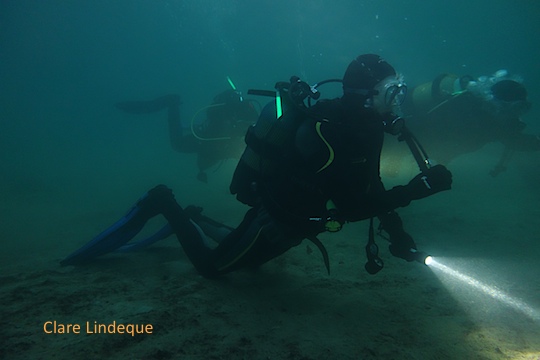It is no secret that Cape Town is a little low on water. The coastal dive industry, even though we spend a lot of time in the ocean, is actually quite a heavy user of fresh water. Everything thing you learn about taking care of your equipment revolves around the phrase “rinse well with clean water.” Clearly this is not an option in Cape Town at the moment.

So how do you maintain your dive gear and keep it in safe condition during such circumstances? For a dive centre or training facility the volume of gear that needs cleaning can be overwhelming at the end of the day. Here are a few suggestions on how to manage.
No matter how well you de-kit after a shore dive, wet dive gear tends to collect sand. (You can minimise this by using something like the Wetsac, but this isn’t always an option with my students.) I take the gear back into the ocean and rinse it as well as I can in the shallows. This involves several trips as wet dive gear is heavy.
Wetsuits are rugged and don’t too much mind being left salty. They do end up being a little crispy after a while, but the most important, non-negotiable aspect is hygiene. I take a spray bottle with a mixture of Savlon or Dettol and spray the inside of the salty wet suit, then let it dry. Gloves, booties, hoodies and rash vests get the same treatment.
Regulators get a similar treatment, without the disinfectant. I give them an overall light spray with warm water in a spray bottle, with a good spray into the mouth piece. The inflator hose nipple also needs to be rinsed well as this does not handle salt build-up too well and could get stuck during a dive (at best, annoying… at worst, life-threatening).
Cameras, dive computers, torches and compasses do need a little more care, but fortunately are relatively small and have lesser water requirements. I use a narrow, tall bucket and put the bucket in the shower. While showering you can easily catch enough water to cover these items…. Seldom more than a litre is required, and you can leave them to soak.
The biggest challenge is a BCD. Again, it is a tough and rugged piece of gear, but the inflator mechanism does not like salt build up. Using the same bucket of water used for the camera and dive computers, I soak the inflators overnight. I then connect an airline and inflate and deflate the BCD to help flush out the valves behind the inflate/deflate buttons.
Whilst such basic, minimalistic care for your dive gear is not as thorough as that recommended by the manufacturer, it is a method of extending the use of your gear when the availability of fresh water is close to zero. As a rule I prefer to only have two students per class and can effectively wash three sets of gear in less than three litres of water.
It goes without saying that as soon as it rains, you should be collecting that water to give your gear the long, luxurious soak it deserves (and probably needs by that stage)!






























